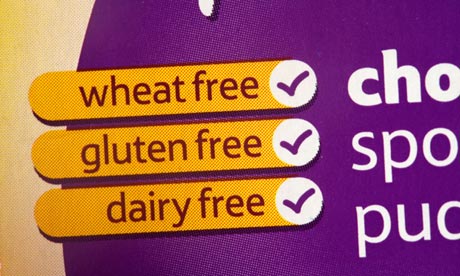
For most foodies, a balanced diet used to be about the nutritious ingredients that went into everyday dishes. But in 2013 the success of free-from products proves that healthy food is just as likely to be defined by what's left out.
Free-from (a catch-all tag for food and drink with elements such as dairy or gluten removed) once languished under the uniquely unappealing label "special diet food". Aimed solely at those that couldn't eat certain food groups for health reasons, in the 80s and 90s you would have to seek it out at the back of your local health store, or even on prescription from a pharmacy.
Today things are different. Free-from food and drink is available everywhere on the high street and represents a £238m market that grew 15% in the UK last year, according to retail analyst Kantar. Starbucks might be stingy when it comes to taxes, but they'll quite happily sell you a gluten-free sarnie to go with your soya latte. Meanwhile you can order in gluten-free pizza from Domino's or stock up on any of the major supermarkets' free-from ranges. And the bigger bread brands are in on the act, with Warburtons behind a new wheat and gluten-free bakery range.
So why is free-from suddenly so popular? It seems that for the first time it is not people who can't eat wheat or dairy that are feeding the market – it's those who don't want to eat it. "There has been a huge growth in the number of 'voluntary restrictors' – people who want to go gluten-free but don't have a medical reason," explains Michelle Berriedale-Johnson, food historian and editor of foodsmatter.com.
In part this trend is a hangover from the days when the Atkins diet was in and "bread was bad". Women's glossies hyping the likes of Gwyneth Paltrow or Victoria Beckham's "amazing gluten-free diet" have contributed to the fad and on Twitter you have Miley Cyrus tweeting: "Everyone should try no-gluten for a week. The change in your skin, physical and mental health is amazing." As Berriedale-Johnson says, "If your favourite Hollywood star looks thin and gorgeous on a gluten-free die, then there's this idea that by going gluten-free you can look that good too."
The biggest driver now, though, is health. Berriedale-Johnson thinks this belief stems from a growing suspicion about what goes into our food; for instance, suspicions that bread manufacturers are adding gluten as a way to bulk out their products, while the image of the "daily pinta" has been tainted now that more people know about the antibiotics and growth hormones used in some milk production.
Whatever the reason for the trend, experts warn that there can be problems with having a gluten or dairy-free diet as a lifestyle choice. Dietician Gaynor Bussell is clear that for people with medical problems, a proper medical diagnosis, followed by a carefully chosen diet, is essential. She advises that over a long period, a voluntarily gluten-free diet can lead to nutritional deficiencies, such as a lack of fibre or B vitamins. "With cutting out dairy you could become deficient in calcium plus some fat soluble vitamins including vitamin D and vitamin B."
So much for the health benefits. But more importantly for foodies – what about the taste?
Berriedale-Johnson happily admits that a couple of decades ago most of the free-from products on the market were "pretty inedible". Anyone who had to buy wheat or dairy-free in the 80s will remember being "treated" to bread with the same consistency and weight as a brick and soya milk that largely tasted of chalk. In 2013, the aforementioned big brands have now managed to deliver free-from products that aren't taste-free. And the proliferation of good quality dairy and wheat-free ingredients (take a bow, Dove's Farm) has led to a recent flourish of small, UK-based artisan free-from producers.
Catherine Lyne from free-from cake producer Cat and the Cream is a prime example of this new breed. In 2010, soon after the company launched, Lyne became worried the brand would be lost in a sea of cupcakes – and saw the free-from category as a way to differentiate it from the competition. "We did some sampling at Whole Foods Market," she says. "People loved the cakes, but they were all asking if we could do sugar- and wheat-free versions. It was mainly City professionals that wanted something healthy and indulgent." Her move into free-from has paid off. Just two years after launch her cakes have been picked up by Ocado.
So now there are good free-from products available - has anyone come across any others? Or any that should have remained firmly in the 80s?

